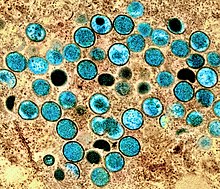
Back فيروس جدري النسناس Arabic Meymunçiçəyi virusu Azerbaijani মাঙ্কিপক্স ভাইরাস Bengali/Bangla Virus de la verola del mico Catalan Virus opičích neštovic Czech Mpoxvirus Danish Virus de la viruela símica Spanish ویروس آبله میمون Persian Virus de la variole du singe French נגיף אבעבועות הקוף HE
| Orthopoxvirus monkeypox | |
|---|---|

| |
| Colorized transmission electron micrograph of monkeypox virus particles (teal) found within an infected cell (brown), cultured in the laboratory. | |
| Virus classification | |
| (unranked): | Virus |
| Realm: | Varidnaviria |
| Kingdom: | Bamfordvirae |
| Phylum: | Nucleocytoviricota |
| Class: | Pokkesviricetes |
| Order: | Chitovirales |
| Family: | Poxviridae |
| Genus: | Orthopoxvirus |
| Species: | Orthopoxvirus monkeypox
|
| Clades | |
| |
| Synonyms | |
|
MPV, MPXV, hMPXV | |
The monkeypox virus (MPV, MPXV, or hMPXV)[1][a] is a species of double-stranded DNA virus that causes mpox disease in humans and other mammals. It is a zoonotic virus belonging to the Orthopoxvirus genus, making it closely related to the variola, cowpox, and vaccinia viruses. MPV is oval, with a lipoprotein outer membrane. The genome is approximately 190 kb. Smallpox and monkeypox viruses are both orthopoxviruses, and the smallpox vaccine is effective against mpox if given within 3–5 years before the disease is contracted.[4] Symptoms of mpox in humans include a rash that forms blisters and then crusts over, fever, and swollen lymph nodes.[5] The virus is transmissible between animals and humans by direct contact to the lesions or bodily fluids.[6] The virus was given the name monkeypox virus after being isolated from monkeys, but most of the carriers of this virus are smaller mammals.[5]
The virus is endemic in Central Africa, where infections in humans are relatively frequent.[5][7] Though there are many natural hosts for the monkeypox virus, the exact reservoirs and how the virus is circulated in nature needs to be studied further.[8]
- ^ "Mpox (monkeypox) outbreak 2022". World Health Organization. Archived from the original on 7 January 2023. Retrieved 7 January 2023.
- ^ "Taxon Details | ICTV". ictv.global. Retrieved 30 August 2024.
- ^ "WHO recommends new name for monkeypox disease" (Press release). World Health Organization (WHO). 28 November 2022. Retrieved 29 November 2022.
- ^ Hibbert CM (11 August 2022). "Baby boomer alert: Will your childhood smallpox vaccine protect against monkeypox?". News @ Northeastern. Archived from the original on 18 November 2022. Retrieved 18 November 2022.
- ^ a b c "WHO Factsheet – Mpox (Monkeypox)". World Health Organization (WHO). 18 April 2023. Retrieved 21 May 2023.
- ^ "Monkeypox in the U.S." U.S. Centers for Disease Control and Prevention (CDC). 18 October 2022. Archived from the original on 26 October 2022. Retrieved 26 October 2022.
- ^ Bunge EM, Hoet B, Chen L, Lienert F, Weidenthaler H, Baer LR, et al. (11 February 2022). "The changing epidemiology of human monkeypox – A potential threat? A systematic review". PLOS Neglected Tropical Diseases. 16 (2): e0010141. doi:10.1371/journal.pntd.0010141. PMC 8870502. PMID 35148313.
- ^ "Mpox in Animals". U.S. Centers for Disease Control and Prevention (CDC). 27 April 2023. Retrieved 8 June 2023.
Cite error: There are <ref group=lower-alpha> tags or {{efn}} templates on this page, but the references will not show without a {{reflist|group=lower-alpha}} template or {{notelist}} template (see the help page).